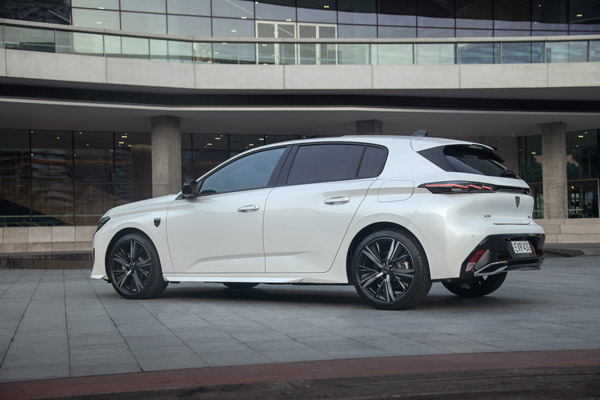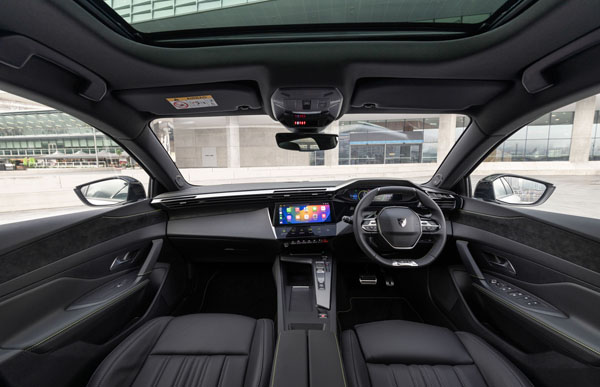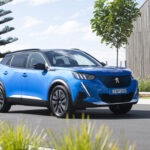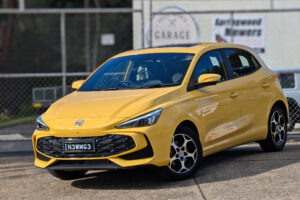
Peugeot’s GT Sport Plug-In Hybrid (PHEV) hatchback has become the fourth model to
join the French carmaker’s 308 compact range.
It joins the GT hatch, GT Premium hatch and GT Premium wagon petrol variants.
First sold here in 2008 the 308 has never seriously challenged comparable models
from Japan or South Korea for sales, but those loyal to the French brand have always
loved it for its style, comfort and handling.
The new 308 PHEV is Peugeot’s third plug-in petrol-electric hybrid, joining the 3008 GT
Sport SUV and 508 Fastback GT with two more set to arrive later this year – the 2008
small SUV and 508 Sportwagon.
Also coming later in 2023 will be Peugeot’s first fully electric vehicles, the e-Partner
small van and e-2008 compact SUV.
STYLING
We love the looks of the latest 308 starting at the front where a large, intricate grille
flanked by LED Matrix headlights and claw-shaped daytime running lights.
The 308 is the first Peugeot model to feature the latest iteration of the iconic Peugeot
lion badge sitting in the centre of the grille as well as on the front side panels, boot lid
and in the centre of the eye-catching black alloy 18-inch wheels.
The rear has also been given a serious makeover with tri-segment tail lights on either
side and the lion-claw in the centre of each.
The battery charging socket is at the rear of the passenger side.

INTERIOR
While the new 308 is slightly longer than the previous model, it’s still a small car and we
found it a little cramped. Headroom is restricted by the panoramic sunroof which forced
us to drop the powered driver’s seat to its lowest level resulting in a lower driving
position than preferred.
The front passenger seat has manual adjustment but, like the driver’s seat, is heated
and comes with a multi-point massage function and lumbar adjustment.
The 308 comes with the latest version of the Peugeot i-Cockpit which combines a small
sports steering wheel with 10-inch digital instrument panel and 10-inch central
infotainment touchscreen, blended and ergonomically positioned.
Rear seat leg and head room is limited, with little knee room.
Boot space is around average for the class with 361 litres when the rear seatbacks are
folded.
All seats have Nappa Mistral leather trim with Tramontane charcoal grey stitching.
POWERTRAIN
308 GT Sport PHEV combines a 1.6-litre 132 kW/250Nm 1.6-litre, four-cylinder petrol
engine with an 81kW electric motor for combined power and torque outputs of 165kW
and 360Nm.
It is integrated with an e-EAT8 transmission, which for this application has the
traditional torque converter replaced with a wet, multi-disc clutch.
As with the other 308 variants the GT Sport PHEV is front-wheel-drive.
The 12.4kWh Li-ion battery with 100kW of battery power and 3.7 kW onboard charger
provides a WLTP test range of 60km in electric-only driving. Fuel tank capacity is 40
litres.
Three driving modes are available: Electric, Hybrid and Sport.
The 308 GT Sport PHEV comes as standard with a mode two charging cable, supplied
with the vehicle at time of delivery. The on-board charger unit restricts the accepted
charger to a capacity of 3.7kW.
Using a domestic power socket with a 2.3kW single-phase 10A charger, the battery will
be charged in around 5.5 hours. With a home charging station such as a Wallbox this
will reduce to about 3.5 hours.
SAFETY
There’s a comprehensive list of safety features across the entire 308 range. Highlights
include autonomous emergency braking with pedestrian and cyclist detection, active
cruise control with Stop & Go function, forward collision warning, long-range blind spot
detection, rear cross traffic alert, lane departure warning with unmarked road edge
detection, advanced driver inattention alert, speed limiter function, tyre pressure
warning and two Isofix child seat mounts.
GT Premium and GT Sport PHEV add active lane positioning assist while the PHEV
gets Acoustic Vehicle Alerting System (AVAS) which generates sound when the car is
travelling at low speed to alert pedestrians.
When tested by ANCAP in November 2022 the absence of a front centre airbag, which
is a relatively new feature, led to 308 getting a four-star rating.

INFOTAINMENT
The infotainment system features satellite navigation, wireless smartphone charging,
wireless Apple CarPlay and Android Auto, two front and two rear USB sockets, wireless
phone mirroring, voice recognition, with Peugeot iConnect and the myPeugeot app.
Like so many recent new vehicles, far too many features, including climate control,
need to be accessed through the touchscreen with the driver’s attention inevitably
being taken away from the road ahead.
There is a power and volume knob for the audio system and there are short-cuts
through a smaller horizontal screen called i-Toggles – but drivers will need to spend a
lot of time learning how to access the various features.
The 308 GT hatch gets a six-speaker sound system, all other variants including the
PHEV step up to a Focal 10-speaker HiFi audio system with 690-watt amplifier.
DRIVING
The low-slung styling of the 308 can make it a bit awkward for taller occupants but it’s a
sporty-ish car so that’s to be expected. Once seated though the seats are comfortable
and supportive.
Peugeot’s have always been among our favourite driving cars and the instant torque
from the 308 PHEV further enhances that enjoyment. It’s great fun to drive both around
town and in the hilly terrain segment of our rural drive route while it cruises effortlessly
on the motorway.
While the PHEV’s battery adds around 230kg to overall weight over its petrol-only
siblings it can still get from zero to 100km/h more than two seconds faster at 7.5
seconds.
The ride is relatively firm but not uncomfortable while steering is light and direct.
Using the outdated NEDC test procedure Peugeot lists fuel consumption at
1.3L/100km for the 308 PHEV. The result is based on starting with the battery fully
charged, travelling the claimed maximum distance in EV mode (60km) before
automatically switching to hybrid mode for the remainder of the 100km trip.
The anomaly in the system is that, after travelling 100km the only way to repeat such
low fuel usage would be to stop and fully recharge the battery before continuing.
During three separate tests the best battery-only distance we could achieve was 52km.
With the battery fully-charged we covered 100km using 3.4L/100km. Although that’s
nearly double the listed figure it’s still pretty good. However, once the battery is flat, and
running in normal hybrid mode including battery regeneration, we averaged a less-
impressive 5.6L/100km.
SUMMING UP
As enjoyable as the Peugeot 308 PHEV is to drive the biggest problem is its price. At
$64,990 plus on-roads it’s between $16,000 and $23,000 dearer than its petrol-only
siblings.
Do the sums and it’s very hard to financially justify spending that sort of money, but no
doubt dyed-in-the wool environmentally-focused Peugeot enthusiasts will be willing to
do so.
All Peugeots come with a five-year unlimited kilometre warranty although the PHEV’s
battery warranty is extended to eight years – but with distance cut to 160,000km.
RATINGS
Looks: 9/10
Performance: 9/10
Safety: 9/10
Thirst: 6/10
Practicality: 7/10
Comfort: 7/10
Tech: 8/10
Value: 7/10
AT A GLANCE
MODEL LINE-UP
308 GT 1.2-litre turbo-petrol five-door hatch: $43,990
308 GT Premium 1.2-litre turbo-petrol five-door hatch: $48,990
308 GT Premium 1.2-litre turbo-petrol five-door wagon: $48,990
308 GT Sport PHEV: 1.6-litre turbo-petrol/electric hybrid five-door hatch: $64,990
Note: These prices do not include government or dealer delivery charges. Contact your
local Premium dealer for drive-away prices.
SPECIFICATIONS (Peugeot 308 GT Sport PHEV: 1.6-litre turbo-petrol/electric hybrid
five-door hatch)
PETROL ENGINE:
Capacity: 1.598 litres
Configuration: Four cylinders inline
Maximum Power: 132 kW @ 6000 rpm
Maximum Torque: 250 Nm @ 1750 rpm
Fuel Type: Premium unleaded petrol
ELECTRIC MOTORS:
Front electric motor: 81 kW / 320 Nm
Battery capacity: 12.4 kWh
Battery Power: 100 Kw
Electric Only Range: 60 kilometres
COMBINED PERFORMANCE:
Maximum Power: 165 kW
Maximum Torque: 360 Nm
Claimed Fuel Consumption: 1.4 L/100km
Claimed CO2 Emissions: 33 g/km
DRIVELINE: Eight-speed automatic
DIMENSIONS, WEIGHT AND CAPACITIES:
Length: 4365 mm
Wheelbase: 2675 mm
Width: 1859 mm
Height: 1465 mm
Turning Circle: 10.5 metres
Kerb Mass: 1633 kg
Fuel Tank Capacity: 40 litres
BRAKES:
Front: Ventilated disc
Rear: Solid disc
STANDARD WARRANTY:
Five years / unlimited kilometres











